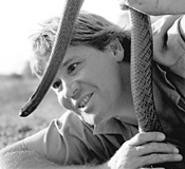A big-screen bow was inevitable, especially after Irwin proved he could act, in FedEx commercials and a teaser trailer for Dr. Dolittle 2. He's an inherently likable guy with a positive message and an inoffensive sense of humor. Heck, he's even donating his entire salary from the film to conservation efforts, so it seems a shame to dismiss his movie. But dismiss it we shall: The man deserves a better vehicle than this.
At the beginning of The Crocodile Hunter: Collision Course, a U.S. satellite goes awry and mostly burns up in the atmosphere, save for a small, indestructible core loaded with CIA spy data. The spinning top-like metal object splashes down in the outback, where it is promptly swallowed by a crocodile. In a quick series of boring scenes, shot with wooden actors on sets that even Roger Corman wouldn't use, CIA agents are dispatched to go undercover to Australia and fetch it. All that's really key to the story is that the crocodile in question periodically snacks on the livestock of obnoxious, fat farmer Brozzie (Babe's Magda Szubanski), and Irwin is dispatched to remove the croc before it tastes shotgun lead, or Brozzie.
Right off the bat, director John Stainton, who created Irwin's Crocodile Hunter TV series but has never directed a film before, makes a curious choice: He shoots all the CIA scenes in wide-screen and Irwin's scenes in TV aspect ratio. At first, it seems as though that's because Irwin is supposedly shooting his documentary show as the action unfolds, but later it becomes clear that, no, there is no documentary crew around within the film's reality -- Irwin's simply talking to the camera.
The montage of Crocodile Hunter TV scenes that runs over the end credits of Collision Course is the funnest thing in the movie. There are plenty of enjoyable moments, none of which has to do with the so-called story -- Irwin improvised much of his own material, and the scenes in which he handles deadly animals for the cameras are real. But why pay for these when you can see them for free on TV?


